|
Pigeon Mating
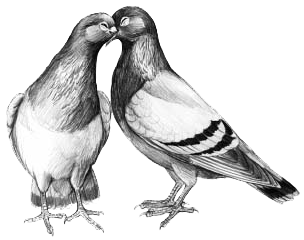 An
adult female pigeon is called a hen, and
an adult male pigeon is called a cock. Cocks
strut, coo, and spread their tail into a full half-moon shape and
often turn a full circle when they want to mate. Hens, on the other
hand, will swell their crops with some air but usually stand at a
more upright angle (45 degrees or so), as opposed to the cock who
almost bows to the floor. On the ground, a cock drives, or chases,
his mate away from An
adult female pigeon is called a hen, and
an adult male pigeon is called a cock. Cocks
strut, coo, and spread their tail into a full half-moon shape and
often turn a full circle when they want to mate. Hens, on the other
hand, will swell their crops with some air but usually stand at a
more upright angle (45 degrees or so), as opposed to the cock who
almost bows to the floor. On the ground, a cock drives, or chases,
his mate away from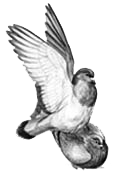 other
prospective suitors. A cock then struts around the hen, eventually
standing up, spreading his tail, and bowing
to coo at her. Other intimate pigeon behavior includes billing, often
a prelude to mating, when the hen sticks her bill down the cock's
throat and takes an offering of regurgitated food (right picture).
This is a part of the courtship and mating rituals of pigeons, and
billing can be followed by preening, when pairs lightly preen each
other's heads. If you spend a few more minutes watching them after
billing, you'll likely witness the behavior leading to copulation
(left picture). After this rather quick mating, sexually active birds,
usually cocks, frequently clap their wings together in a sort of
advertising flight, and may combine the claps with an ostentatious
glide, with wings held in a "V" and tails spread. other
prospective suitors. A cock then struts around the hen, eventually
standing up, spreading his tail, and bowing
to coo at her. Other intimate pigeon behavior includes billing, often
a prelude to mating, when the hen sticks her bill down the cock's
throat and takes an offering of regurgitated food (right picture).
This is a part of the courtship and mating rituals of pigeons, and
billing can be followed by preening, when pairs lightly preen each
other's heads. If you spend a few more minutes watching them after
billing, you'll likely witness the behavior leading to copulation
(left picture). After this rather quick mating, sexually active birds,
usually cocks, frequently clap their wings together in a sort of
advertising flight, and may combine the claps with an ostentatious
glide, with wings held in a "V" and tails spread.
Once paired, pigeons usually
mate for life unless they are separated by natural causes or by humans.
The domestic pigeon normally reaches sexual maturity at about four to six
months of age. Depending on the local temperatures and food supply, they
may breed all year round. Many domesticated pigeon fanciers, however, prevent
them from breeding continuously---either by separating the sexes or by
letting mated pairs sit on wooden (dummy) eggs. Once mated, the male (cock)
will begin to hunt for a suitable place to make a nest and rear the young.
Domesticated pigeons do not nest in trees as do many other doves. They
are descendants of a cliff dwelling species and prefer their nest to be
on a solid surface. Most fanciers (breeders) also provide a nest bowl and
some nesting materials (pine needles, tobacco stems, etc.). The nest bowl
helps to ensure that the eggs do not roll out from under the pair.
New Eggs
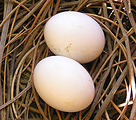 When
pigeons start mating, the hen usually lays her first egg eight days later
and the second egg two days after the first egg. The first time they lay,
it is normal for young hens to lay smaller than average eggs or only one
egg in her first clutch. Pigeons usually lay two purely white eggs in confinement,
but never more than two, unless, from the absence of a sufficient number
of male birds, two hens pair, make a nest, and lay four eggs, which of
course are sterile. Unfertilized eggs, after being sat upon for the usual
period are deserted. The first egg is usually laid in the evening between
5 P.M. and 7 P.M. Because one of the hen's ovaries never develops, hens
can only produce one egg at a time. It takes about two days for the second
egg to develop in the ovary after the first is laid and has cleared the
oviduct. The second egg is usually laid in the afternoon between 2 P.M.
and 3 P.M. It is suggested that the breeders should take the first laid
egg away from the parents and not let them start the incubation process
until the second egg is laid. Otherwise, the first laid egg will hatch
36-48 hours earlier than the second. This will cause the first baby to
be nearly twice the size of the newly hatched second chick. The parents
may choose to neglect the second chick as they may think the survival chance
of the first and bigger chick is greater than the younger and weaker chick.
As you will notice in the pictures below, I do not remove the first egg
so that both chicks can hatch at the same time. I give my breeders more
than enough food to feed their offspring, and I never had any problems
with this. I also try not to handle the eggs or disturb the parents during
their incubation. The developing embryo is very fragile and just a little
shaking can cause its death. When
pigeons start mating, the hen usually lays her first egg eight days later
and the second egg two days after the first egg. The first time they lay,
it is normal for young hens to lay smaller than average eggs or only one
egg in her first clutch. Pigeons usually lay two purely white eggs in confinement,
but never more than two, unless, from the absence of a sufficient number
of male birds, two hens pair, make a nest, and lay four eggs, which of
course are sterile. Unfertilized eggs, after being sat upon for the usual
period are deserted. The first egg is usually laid in the evening between
5 P.M. and 7 P.M. Because one of the hen's ovaries never develops, hens
can only produce one egg at a time. It takes about two days for the second
egg to develop in the ovary after the first is laid and has cleared the
oviduct. The second egg is usually laid in the afternoon between 2 P.M.
and 3 P.M. It is suggested that the breeders should take the first laid
egg away from the parents and not let them start the incubation process
until the second egg is laid. Otherwise, the first laid egg will hatch
36-48 hours earlier than the second. This will cause the first baby to
be nearly twice the size of the newly hatched second chick. The parents
may choose to neglect the second chick as they may think the survival chance
of the first and bigger chick is greater than the younger and weaker chick.
As you will notice in the pictures below, I do not remove the first egg
so that both chicks can hatch at the same time. I give my breeders more
than enough food to feed their offspring, and I never had any problems
with this. I also try not to handle the eggs or disturb the parents during
their incubation. The developing embryo is very fragile and just a little
shaking can cause its death.
Foster parenting
If you are a pigeon breeder, at
some point you will want to switch eggs under foster parents for one reason
or another and replace them with other eggs from other parents. This is
usually done because you want more babies from one pair, and you don’t
want to wait two months for two babies. Instead, you want to foster the
eggs under other pairs so that the pair you are trying to get offspring
from could lay their next round of eggs in 10 days to raise more babies.
Foster parenting is very common when breeding pigeons. This is easily done,
but the timing of incubation with both pairs needs to be similar. Usually,
if the sets of eggs are laid within three days of each other, the switch
goes successfully. If it is more than that, the babies may hatch too early,
and that will cause babies to perish because the foster parents will not
have sufficient crop milk. On the other hand, if they hatch too late, the
foster parents may desert the eggs or already be on the downside of crop
milk production. Every time my breeders lay eggs I write down the date.
This allows me to estimate the date of hatching. It also helps me to achieve
the proper timing for foster parenting. Eggs can be easily held for three
to five days at room temperature, before incubation has started, and placed
under foster parents when the timing is right. Eggs held in the hydrator
drawer of a refrigerator can be held somewhat longer. If you decide to
pull the first egg from the parents, make sure to keep the egg in a cool,
dark place on a layer of soft tissue paper until the next egg is laid,
and then return it to the nest. To avoid soft shells, which can be caused
by poor nutrition, diet or deficiency of calcium (grit), give your breeders
a lot of grit and more than usual food. I have noticed some of my breeders
don't incubate steadily on an egg until the second egg is laid. This is
why many times both eggs hatched around same time.
Incubation
The parents take turns
keeping their eggs warm (incubating).
Incubation is not equally shared since the hen
does most of the work each day. Only when she leaves the nest, does the cock
assumes the duties. Cocks usually stay on the nest during the day, and the
hen takes over after 5 P.M. until late morning. If an egg cools down too much
after incubation has started, the egg will not develop and hatch. The parents
need to keep a steady temperature of about 102-105 degrees Fahrenheit, 24 hours
per day for the embryo to properly develop. The hen or cock will get off the
nest when nature calls, eat and drink but will resume incubating right away,
not letting the egg lose its temperature. After five days, the eggs may be
inspected to see if they are fertile. It's easy to inspect an egg; just hold
the egg up to a bright light. If the egg is fertile, you can see the blood
vessels through the thin shell. If it is not fertile, the eggs will look clear
inside. After the fifth day of inspection, try not to handle the eggs or disturb
the incubation for the remaining of its process.
Hatching
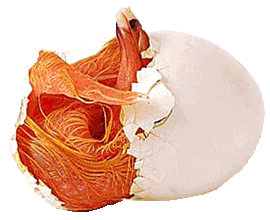 Under
normal circumstances, the first egg will hatch after 18 days and the second
egg after 19 days if parents started to incubate when the first egg was
laid. Otherwise, they will both hatch on the same day. The hatching process
takes from 15 to 30 hours. The newly hatched pigeon is called a hatchling.
During hatching, you should NOT help a baby out of an egg. The baby develops
the muscles in his neck, legs, and body as he pushes out of the egg. This
may take 24-36 hours or longer from the initial pip until the baby is out.
If you interfere with the egg, you will most likely cause the baby to bleed
to death. There are many tiny blood vessels lining the egg. Breaking these
will kill the bird. If you allow the bird enough time, the blood vessels
will dry and the bird can hatch. The baby depends on nutrients available
from the yolk; these are absorbed into the baby's belly. It is also very
important not to move the egg during the few days before the bird hatches.
The baby will orient itself inside the egg so that its head is at the larger
end of the egg near the air sac. The baby pips its way through the shell
using the edge of its beak. Once a hole is made, the baby needs to rest
for several hours and acclimate its lungs to the outside air. The baby
should not be disturbed during these critical phases. The baby will turn
inside the egg and continue to struggle until it's out of the shell. Under
normal circumstances, the first egg will hatch after 18 days and the second
egg after 19 days if parents started to incubate when the first egg was
laid. Otherwise, they will both hatch on the same day. The hatching process
takes from 15 to 30 hours. The newly hatched pigeon is called a hatchling.
During hatching, you should NOT help a baby out of an egg. The baby develops
the muscles in his neck, legs, and body as he pushes out of the egg. This
may take 24-36 hours or longer from the initial pip until the baby is out.
If you interfere with the egg, you will most likely cause the baby to bleed
to death. There are many tiny blood vessels lining the egg. Breaking these
will kill the bird. If you allow the bird enough time, the blood vessels
will dry and the bird can hatch. The baby depends on nutrients available
from the yolk; these are absorbed into the baby's belly. It is also very
important not to move the egg during the few days before the bird hatches.
The baby will orient itself inside the egg so that its head is at the larger
end of the egg near the air sac. The baby pips its way through the shell
using the edge of its beak. Once a hole is made, the baby needs to rest
for several hours and acclimate its lungs to the outside air. The baby
should not be disturbed during these critical phases. The baby will turn
inside the egg and continue to struggle until it's out of the shell.
When they get out of the shell, they
will be wet and exhausted and will usually lie still. After some time,
they will begin to perk up. When the chicks have hatched and have dried,
they are fed by their parents within the first hour. Try not to handle
the hatchlings as they are very fragile and need protection and warmth
from their parents. Parents should be provided food and drinking water
to produce pigeon milk for the hatchlings; unlike mammals, both sexes produce
the crop milk in pigeons.
First 30 days
The young pigeons are born in
a most immature and helpless condition. The young are usually covered with
long yellow down, but in those domesticated varieties that have certain
colors, this down may be absent as in the silver and dun birds. Thus, it
is easy to distinguish between a young dun and a black in the same nest,
the one being naked, the other covered with profuse yellow down. A young
pigeon, until the age of 30 days, is called a squab. Squabs are fed by
a special substance called pigeon milk during their first week of life.
Pigeon milk is made in a special part of the bird's digestive system called
the crop. To feed their young, pigeons do something almost no other parents
can: they both nurse their young. They produce high power milk that is
so nutritious, the squabs can double their size in just 48 hours. The pigeon
milk is a super-charged food with more proteins and fat than cow or human
milk. Although it's high in fat, to help the young squabs develop fast,
it's also packed full of antioxidants and immune-system-boosting proteins.
(Considering pigeons spend their entire lives in urban squalor, they must
have incredible immune systems.) Pigeon milk fuels the most explosive growth
rate of almost any animal on the planet. Squabs eat almost as much as their
own weight of pigeon milk every day. In just two weeks, they become half
the size of their parents. After 25 days, they are nearly fully grown and
can feed themselves. After 35 days, they leave home. When hatchlings are
about ten days old, they are being fed on a straight grain diet. Most pigeon
breeders band their birds with seamless bands (ring), and the time to do
so is between five and twelve days, depending on the pigeon breed and speed
of growth. After about two weeks, the chicks are left alone in the nest
for longer periods as the parents, especially the hen, will start ignoring
the chicks as the pair is preparing for the next round of eggs. After 14
to 18 days, the cock pretty much cares for the babies alone. The youngsters
are weaned by about 30 to 35 days, but at about 21 days most parent birds
will have already gone to nest again. They should have another nest bowl
and nest area (it can be the other end of their nest box) available to
them. Most hens will stop feeding the young once they lay again, and the
cock bird will bear the brunt of feeding the babies until their final weaning.
A young bird who is learning to eat and drink on its own is called a squeaker.
When a young bird is ready to fly, it is called a fledgling. When the young
bird is flying but is less than six months old it is called a juvenile.
Pigeons normally don't reach maturity level to breed until they are four
to six months old.
There are a lot of different ways
pigeon breeders use to determine the sex of the young birds. One of the
ways that I use and find very accurate most of the time is measuring their
toes. When banding the babies, looking from the underside of the foot,
lay the three toes straight alongside each other. Leaving the middle and
longer toe in the middle, align the other two next to the middle one and
compare the outside toes against each other. If one of the outside toe
is longer than the other one, the youngsters are “generally” cocks.
If they are equal in length, then the youngster is “generally” a
hen. This method can be used with pigeons up to one month old as the feet
after that cannot be relied on since the feet alter shape when the bird
has been walking on them for some time. Although there are other methods
to determine the sex of pigeons, this method works best for me. However,
please note that none of the known methods are 100% accurate. The pigeons
that lay eggs are 100% hens, and that’s the only accurate way of
sexing pigeons.
Correcting Splay
Leg
Some baby pigeons develop splay
leg, a condition in which one or both legs stick out to the side and the
bird is unable to stand. This problem might be caused by improper bedding
in the nest (the surface is too slippery), or by a disturbance (the bird
is shaken or thrown), or by poor nutrition (lack of calcium in the diet).
Sometimes, only one egg hatches in the nest. When that happens, I leave
the unhatched egg in the nest for 10 more days for the hatched baby to
lean on to prevent splay leg.. 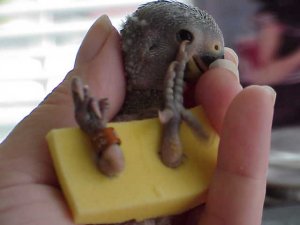
Splay leg can be corrected, but it
is very important to start the rehabilitation as soon as you are aware
of the condition. To correct splay leg, you will need to secure the legs
in their natural position. The most effective way is to use a small sponge.
Make two slits in the sponge using the scissors’ point. Turn the
scissors to make a round hole. The two slits should be just wide enough
that the legs will go straight down from the body. Don't put them too close
together as they will tear into each other. You have to find a balance
here. You don't want to harm the bird's legs by over-forcing it, but you
will have to pull on them a bit to get them properly situated.
You can also use vet tape (self-adhesive
gauze). Place the legs under the bird in their natural position (about
one inch apart), and run the tape around the legs. You might need to lay
the baby on its back to do this. You can wrap tape around the section between
the legs to keep the legs apart. Alternatively, you can use any kind of
soft material (gauze, sponge, cotton) between the legs. Be very careful
that you do not cut off circulation in the legs. You will want to check
the bird regularly and change the tape when it gets soiled.
The bird will be very clumsy at
first, but it will soon learn to stand with its legs in their correct position.
The time needed for healing could be one to three weeks. If you do not
see improvement, you should take the bird to a rehabilitator or avian vet.
|
|
Training Young Performing
Birds
There are many different ways and
styles to train young performing birds, and you can use the same methods
to train any other breed. I would like to share how I train and fly my
performing breeds like Turkish Tumblers, Iranian High Flyers, and Birmingham
Rollers. I use the same method for all of them, and it works for me.
The young birds should be separated
from their parents when they are about 30 days old. By that time, they
are able to eat and drink on their own and get ready for their flight training.
Training for flights is essential to keep a young bird from becoming too
fat and lazy. It is important to mix the young ones with the rest of the
birds as soon as they are old enough so they can learn a lot of different
things from the adults. By watching the adults, the young ones know where
the water and food is, how to get in and out of the coop, etc. In addition,
the young birds get used to breeders’ movements and the distinct
sounds when he/she calls them.
I always use a distinct whistle
and shake my food can before I feed my birds. As soon as they hear that
sound, they know it's time to eat. Most of them even know and get excited
when I get near the food containers as they can predict that I am about
to feed them. This is very important for young birds to learn and follow
for the future. I fly and feed my birds once a day. My flying birds know
that they only get to eat after they fly. This discipline gives me total
control over my birds. This way, I can call them anytime I want by making
my distinct sound and use their hunger to my advantage. The last thing
a breeder would want is to see his/her birds to land elsewhere than their
own coop. When flown hungry, the birds will not land elsewhere, or even
if they did, they will not stay there long as they know that they will
be fed soon. If I see a bird that does not land on my coop and does not
come after I call all my birds, I don't feed that bird that day. By the
time the bird comes to my coop, there is little or no food left, and that
teaches the bird a hard lesson not to be late for dinner again. Believe
it or not, this works. Management of feeding pigeons should be the way
the fancier make his/hers birds obedient. However, this does not mean starving
them into submission but rather instilling in them the knowledge that they
will get fed after they fly and trap in unhesitatingly.
After I separate the babies from
their parents, I wait about a week for them to get used to living a life
without their parents' guidance and protection. They get to learn where
the water is and when the feeding time is as well as how to get out of
the coop and come back for safety. They are reluctant and afraid to go
out in the beginning, but they get used to it very quickly. Then I start
using them as my droppers. When I want my flying birds to land, I let my
breeders go out, and I make my distinct noises, letting them know that
it’s time to land and eat. When I start training the young birds,
I use my young birds as droppers instead of the breeders. This gives young
birds a chance to observe the flyers and watch them land. This goes on
about a week, and during that time, I observe my young birds. Young ones
take off and start flying and landing with the adults. This is how I know
if young birds are ready to fly and be trained.
Once the young birds start showing
interest in flying by circling over the roof couple of times, it is time
to train them with the adults. It is very important, however, not to release
the babies with the adults at the same time. Otherwise, the adults will
take them very high up in the air, and the babies will get tired. This
will make them get lost or land somewhere else than the coop, which is
a bad habit to learn in the early ages. Because of my work schedule, I
train my birds to fly for about an hour. When I am training young birds,
I start flying the young birds when the adults are about to land. At first,
about five minutes before my adult flyers land, I release the young birds
in training. A couple of days later, I start flying them during the last
10 minutes and increase their flying time little by little every day. Eventually,
the young birds will have built enough chest muscle and endurance to fly
the same amount of time as the adults. Depending on the breed and family
of the bird, as young birds start flying longer and keeping up with the
rest, they also start tail riding and eventually tumbling or rolling. They
get better as performers and reach their performing potential in a year.
Early training of a young performance
breed bird is very important and should be done as soon as they are able
to fly. As the young birds continue to grow, it is important for their
chest muscles to be developed during flight to take a different shape,
which will allow for their vertical climbs for Tumblers and somersault
for Rollers.
Copyright 2011 by Arif Mümtaz.
All rights reserved. |